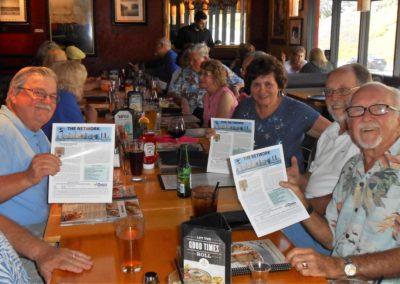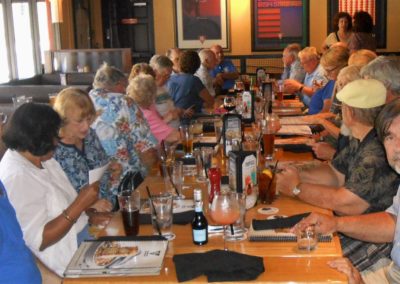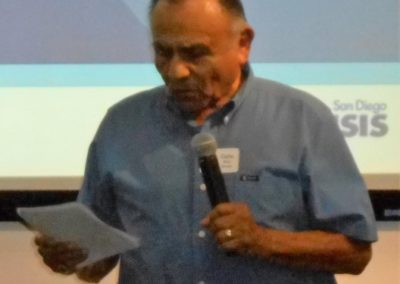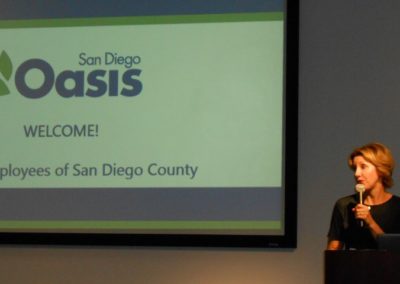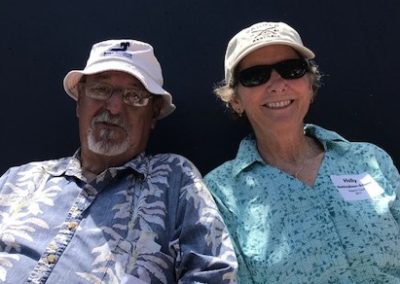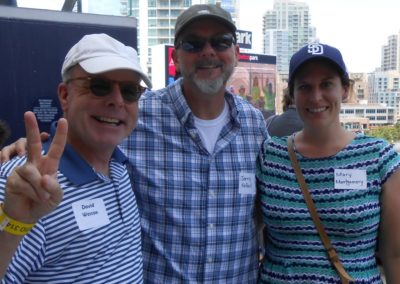September 2018
Honoring Yesterday – Protecting Tomorrow
Vol. 49, No. 9
What’s Inside
- President’s Message
- A Retirement Crisis by Any Other Name
- Coming Home to the Sheriff’s Crime Lab
- Statement to the Board of Supervisors
- RESDC Event Photos
- Walk4ALZ
- North County RESDC Roundup
- Pension Facts
- SDCCU Save for Long-Term Care Seminar
- Annual RESDC Membership Survey
- Recent Events
- Health Fair Picnic Registration
- Bits and Pieces
- Welcome New Members
September Calendar of Events
Mon, September 3
Labor Day
RESDC Office and SDCERA Office closed
Thurs., September 13, 9:30am
RESDC Board of Directors Meeting
8825 Aero Drive, Suite 205
Weds, September 19, 10:00am
SDCCU Long-Term Care Seminar
San Diego Workforce Partnership Office
3910 University Ave., San Diego, 92105
Thurs, September 20, 9:00am
SDCERA Board of Retirement Meeting
2275 Rio Bonito Way, Suite 200
Weds, September 26, 3:30pm
RESDC Roundup North County
Brigantine Restaurant Escondido,
421 W. Felicita Ave., Escondido, CA 92025
![]() View the NETWORK
View the NETWORK
as a printable PDF
Are you on social media?
Stay connected with us!
![]()
![]()
![]()
Quote of the Month
“Correction does much, but encouragement does more.”
– Johann Wolfgang von Goethe
President’s Message
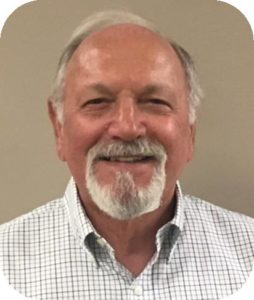
By John J. McTighe
Last month, the RESDC Board held our annual retreat where we spent considerable time reviewing and updating our Strategic and Advocacy Plans. Much effort and thought have gone into the formulation of those two plans in the past. Every year we assess our progress and determine whether there are any items that should be added, changed or deleted from these plans.
I’m a firm believer that the strategic plan of an organization reflects the health of that organization. If the plan is stale and hasn’t been updated in a long time, the organization is also stale and not serving its members well.
Our members have joined RESDC for several reasons. First and foremost, they have joined to have a collective voice and firm advocate on their behalf for defined benefit retirement plans in general, and the San Diego County Employees Retirement Association (SDCERA) pension system in particular. They have also joined RESDC to have opportunities to interact with others who have shared interests. Some have joined so they will receive information to help them navigate their “golden years” of retirement.
I’m pleased to report that RESDC is pursuing all these purposes. I want to highlight some of the objectives in our Strategic Plan and the results we have achieved over the past year.
As I’ve said, first and foremost we are an advocate for defined benefit retirement plans. To that end, our very first objective is to be well informed on legislative proposals/initiatives introduced in both the U.S. Congress and California Legislature and to maintain strong advocacy on issues that impact our members. We achieve the first part of this objective through active membership and participation in the California Retired County Employees Association (CRCEA), the San Diego Regional Retirement Security Roundtable, and the State Association of County Retirement Systems (SACRS). In addition, we are networked with the County’s Aging and Independence Services and the California Senior Legislature from which we receive information that we either pass along to our members or use to help us formulate specific advocacy positions.
Our second objective is equally important and essential. It states, “We will 1) advocate for the protection of currently held retirement funds at the Board of Supervisors and the Board of Retirement; 2) oppose the erosion of retirement benefits; 3) advocate for the enhancement of benefits; 4) communicate with members; and 5) monitor SDCERA actions and operations.” Over the past year, our Executive Director Mark Nanzer and I, as the principal spokespersons for RESDC, have made statements to both the Board of Supervisors and the Board of Retirement in keeping with this objective. Recently in July, Mark appeared before the Board of Supervisors to express RESDC’s support for a proposed amendment to the County Charter to lock in commitments that the Board of Supervisors have made to fund County retirement. RESDC representatives are always present at Board of Retirement meetings and we invite Retirement Board members as special guests at our Board meetings several times a year.
We are pursuing several other objectives, including efforts to increase membership and the benefits of membership, communicating clearly and frequently with members, providing scholarships to members’ relatives, and encouraging volunteerism. All of those are important and have been given attention by the Board and staff. Space limitations do not allow me to go into detail explaining these.
As I’ve mentioned in past NETWORKs, RESDC will be hosting the Spring 2019 conference of the California Retired County Employees Association (CRCEA). Last year, we added an objective to our Strategic Plan for this purpose. I’m pleased to report that our review of the progress in accomplishing this objective showed that we are well on track to have a very successful conference. Even though we were eight months away from the actual conference at the time of our retreat, our staff and Board members involved in the planning have already achieved a lot. We have secured a hotel venue, confirmed the keynote and most other speakers/panelists, secured a major sponsor and designed a conference webpage. As we get closer to the conference, we will need help from some of our members to take care of many of the logistical details associated with the conference. If you are interested in helping out, please call our office to let them know.
I’m looking forward to this year’s Coming Home event on October 4th at the brand-new County Crime Lab located on the campus of the County Operations Center. We’ll hear from the Crime Lab director how they are using state-of-the-art equipment and science in support of solving crimes in the San Diego region. Then, we’ll have a chance to tour the facility seeing the lab in action. Also, in October, we have our annual Health Fair Picnic at Admiral Baker Field in the Grantville area on Tuesday, October 23rd. This is a great opportunity to find out about various healthcare services and plans, and to catch up with many of your fellow retirees. I hope to see many of you at either the Coming Home event or the Health Fair Picnic. ◾
A Retirement Crisis by Any Other Name
By Stan Coombs, Director
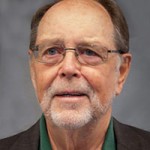 “Is There a Retirement Crisis?” “There is a Retirement Crisis.” “How to Solve The Retirement Crisis.” “The Big Myth About America’s Retirement Crisis.” And, perhaps most intuitively, “Whose Retirement Crisis?”… are a few variations on the subject.
“Is There a Retirement Crisis?” “There is a Retirement Crisis.” “How to Solve The Retirement Crisis.” “The Big Myth About America’s Retirement Crisis.” And, perhaps most intuitively, “Whose Retirement Crisis?”… are a few variations on the subject.
What is it about retirement that’s supposed to be critical? Depends on where you’re standing. If you’re a financial or political bigwig, or a conservative publication, the crisis is probably the $1 trillion-to-$3 trillion gap between funds held by U.S. state and local governments and what they say they’ll need to cover promised retirement benefits. If you’re a socially conscientious American, you’ll think it’s the $7.7 trillion personal savings gap (in 2013) between the funds held in hand for retirement by all working American households and what they will ultimately need.
In fact, the Federal Reserve’s “Survey of Customer Finances,” says that retirement accounts for all U.S. working households average only $3,000, $12,000 for near-retirement (55+) households, and that 38 million, or 45% of working households, actually have zero retirement savings.
This savings crisis transcends national boundaries. The World Economic Forum reports that the retirement savings gap for the six countries with the largest national retirement systems, the U.S., U.K., Japan, Netherlands, Canada and Australia, is expected to reach a combined $224 trillion by 2050. And with China and India added, the world’s two most populous countries, the total rises to $400 trillion. A reminder for those of us who usually think in smaller terms, $1 trillion is 1,000 billions.
Conservative observers argue that funding the government retirement deficits will use monies required for other important needs, and that public retirement is over-rich. Yet, the National Association of Public Administrators calculates pension contributions totaling only 4.7% of U.S. state and local government spending in 2015, apparently leaving over 95% of their financial resources for other priorities. And based on the Census data, The National Institute on Retirement Security calculates average U.S. state and local government pensions to be $27,415 in 2016, ranging from $16,441 in West Virginia to $37,934 in Connecticut. Hardly excessive!
Even with such moderation, U.S. tax dollars only pay for about 35% of the cost of public retirement benefits. The rest comes from employee payroll deductions and fund investments.
Finally, The National Institute on Retirement Security notes, in their “Pensionomics 2016: Measuring the Economic Impact of Defined Benefit Pension Expenditures,” that the U.S. economy significantly benefits from pensions. Pensions support 7.1 million jobs, provide $1.2 trillion in economic output overall, they say, and produce $9.19 in total output from every taxpayer dollar contributed.
So, what’s to come? Well, that $400 trillion savings gap projected for 2050 assumes continuation of a 5% average annual growth of the gap for lots of reasons.
Life expectancy is increasing by three years per decade, increasing the elderly population, total retirement costs and savings requirements. Personal savings rates remain significantly lower than the 10% to 15% needed. Levels of financial literacy are very low worldwide. Professional management of retirement investments has diminished with the loss of managed defined benefit plans. And long-term investment earnings expectations have reduced.
What to do? The Harvard Business Review’s Teresa Ghilarducci and Tony James have suggestions. They want to toss out company-by-company retirement in the private sector, saying it places responsible companies with retirement plans at a competitive disadvantage to less responsible firms, and doesn’t work well with our mobile workforce. They claim their proposal requires no new taxes, doesn’t increase existing taxes or deficits, and reduces administrative burdens on companies.
They say every worker should contribute at least 1.5% of every paycheck into a personal Guaranteed Retirement Account (GRA) until retirement, matched by 1.5% contributions from employers. Workers would receive up to $600 in tax credits almost offsetting contributions for workers earning below median income, accomplished, say Ghilarducci and James, by “redeploying” existing tax credits for 401(k)s. They claim current 401(k) tax credits disproportionately benefit higher-income employees who are not at retirement risk. That may be a difficult sell.
The pooled GRA’s would be professionally invested, increasing earnings and reducing administrative costs and fees, and upon retirement convert into government guaranteed annuities based on the GRA balance, providing consistent, life-long income.
Certainly better than not saving, but similar to the coming California Secure Choice savings arrangement, wherein private sector employees are automatically enrolled in a payroll savings and investment program, which-they-are-free-to-opt-out-of-but-unlikely-to-do-so. And it has similar drawbacks. It provides modest encouragement to upgrade lagging savings, but no assurance adequate lifetime retirement income, or a COLA mechanism to address inflation over decades of retirement.
A universal, professionally managed, defined benefit program is tough to beat. ◾
You’re Invited!
Coming Home to the New San Diego County Sheriff’s Crime Laboratory
When
Thursday, October 4, 2018 at 11:00am
Where
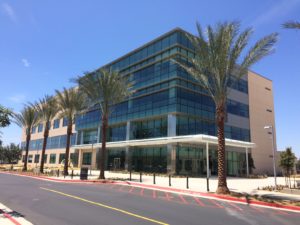 San Diego County Sheriff’s Crime Lab
San Diego County Sheriff’s Crime Lab
County Operations Center
5590 Overland Ave., San Diego, CA 92123
What
Our annual “Coming Home” event invites retired employees of San Diego County to celebrate County sites. On October 4th, we invite you to join your fellow RESDC members in “coming home” to the County’s new Crime Lab.
The San Diego County Sheriff’s Crime Laboratory is the third phase of the County Operations Center Development, the largest public works project in the history of the County. The site of the new crime lab was occupied by the existing fleet maintenance facility, which was relocated to clear the site for the new crime lab. The new crime lab integrates seamlessly with the COC campus and houses 200 employees, allowing forensic lab technicians, property and evidence storage facilities, and detectives to all operate under the same roof for the first time.
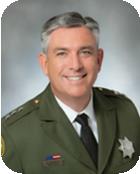 Our event will kick off with welcoming remarks from Mike Barnett, Undersheriff of San Diego County. Mike has been serving the people of San Diego County as a deputy sheriff since 1991. He served as a deputy sheriff in the Detentions and Law Enforcement Bureaus, then a field training officer at the Vista Station and a detective for several years in San Marcos and at the Central Investigations Division. As undersheriff, he serves as the chief deputy of the elected sheriff overseeing all department operations and ensuring San Diego County remains the safest urban county in the nation. He is responsible for the department’s $850 million budget and 4,364 authorized employees. The men and women of the San Diego County Sheriff’s Department operate 20 patrol stations, seven detention facilities, seven Superior Court facilities and the related Civil Division, a nationally accredited Crime Laboratory, and other functions necessary to provide for public safety.
Our event will kick off with welcoming remarks from Mike Barnett, Undersheriff of San Diego County. Mike has been serving the people of San Diego County as a deputy sheriff since 1991. He served as a deputy sheriff in the Detentions and Law Enforcement Bureaus, then a field training officer at the Vista Station and a detective for several years in San Marcos and at the Central Investigations Division. As undersheriff, he serves as the chief deputy of the elected sheriff overseeing all department operations and ensuring San Diego County remains the safest urban county in the nation. He is responsible for the department’s $850 million budget and 4,364 authorized employees. The men and women of the San Diego County Sheriff’s Department operate 20 patrol stations, seven detention facilities, seven Superior Court facilities and the related Civil Division, a nationally accredited Crime Laboratory, and other functions necessary to provide for public safety.
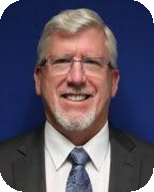 Mike Grubb, Sheriff’s Crime Laboratory Director will then provide an introduction and overview of the new crime lab. Mike is a 1975 graduate of the University of California, Berkeley, Forensic Science Program in the School of Criminology. From 1975 to 1980, Mike was a criminalist at the Institute of Forensic Sciences in Oakland, Calif. In 1980 he moved to the Seattle area and went to work for the Washington State Patrol Crime Laboratory System (six labs), conducting casework in Trace Evidence, Firearms, Biology, and Crime Scenes. He became a supervisor in 1989 and eventually became the Crime Lab Director in Seattle in 1996. In 1999 Mike accepted the position of Crime Lab Manager at the San Diego Police Department Crime Lab, and was there 12 years before moving over to the Sheriff’s Regional Crime Laboratory in December 2010. He is a member of the American Academy of Forensic Sciences, the American Society of Crime Lab Directors, and the California Association of Crime Lab Directors. He is a former Chair of ASCLD/LAB, the international crime laboratory accrediting body.
Mike Grubb, Sheriff’s Crime Laboratory Director will then provide an introduction and overview of the new crime lab. Mike is a 1975 graduate of the University of California, Berkeley, Forensic Science Program in the School of Criminology. From 1975 to 1980, Mike was a criminalist at the Institute of Forensic Sciences in Oakland, Calif. In 1980 he moved to the Seattle area and went to work for the Washington State Patrol Crime Laboratory System (six labs), conducting casework in Trace Evidence, Firearms, Biology, and Crime Scenes. He became a supervisor in 1989 and eventually became the Crime Lab Director in Seattle in 1996. In 1999 Mike accepted the position of Crime Lab Manager at the San Diego Police Department Crime Lab, and was there 12 years before moving over to the Sheriff’s Regional Crime Laboratory in December 2010. He is a member of the American Academy of Forensic Sciences, the American Society of Crime Lab Directors, and the California Association of Crime Lab Directors. He is a former Chair of ASCLD/LAB, the international crime laboratory accrediting body.
Event Highlights
11:00 am – Reception, light hors d’oeuvres and refreshments available
11:20 am – Welcoming Remarks by RESDC and County of San Diego Undersheriff Mike Barnett
11:35 am – Introduction & Overview of the Crime Lab by Mike Grubb, Sheriff’s Crime Laboratory Director
12:00 pm – Guided Tours
Directions
From the North or South:
From 163, exit east onto Clairemont Mesa Blvd. Turn left (north) onto Overland Avenue.
From I-15, exit west onto Clairemont Mesa Blvd. Turn right (north) onto Overland Ave.
From the East or West:
From 52, exit south onto Ruffin Road. Turn Right into Parking Structure or proceed to Overland.
To access the parking structure from Overland, turn right onto Farnham Street. Parking structure is on the left.
RSVP
This is a FREE event. RSVP is requested but not required: online by clicking here and following the steps, or by calling (619) 688-9229. ◾
RESDC Executive Director Statement
July 24, 2018 Meeting of San Diego County Board of Supervisors
At the July 24, 2018 Board of Supervisors meeting, RESDC Executive Director Mark Nanzer spoke in favor of a county charter amendment proposed for the November ballot and expressed RESDC’s concern to County Supervisors that creation of a new lower Tier D benefits class this year for new employees could be problematic. The charter amending ballot measure would include the following:
Pension Stabilization – Once the Board of Supervisors has appropriated funds for pension stabilization, these funds shall not be used for any other purpose other than pension-related liabilities.
Long-Term Debt – proceeds from any long-term obligation of the General Fund of the County shall not be used to finance current operations for recurring needs.
The Board of Supervisors unanimously approved the agenda item.
The Executive Director’s public statement follows:
Madam Chairwoman and Members of the Board. I am Mark Nanzer, Executive Director of the Retired Employees of San Diego County (RESDC). Thank you for the opportunity to speak.
A primary focus of RESDC has always been to support adequate, secure, economically sound retirement benefits earned and partially funded by county employees. We also support the good financial management policies the County has regularly followed to ensure it can meet all its retirement funding obligations on time.
The proposed new Charter Sections 800.1 and 800.2 appear to fortify the Board’s sound fiscal budgeting practices. While descriptive detail outlining how the new Charter Section 800.1 might apply to pension stabilization in all cases is generally absent from the board letter, we believe that funds allocated for real pension stabilization should be protected, insofar as possible, from random, non-retirement uses in the future.
These are sensible good government measures that RESDC can easily endorse. Still, as former county workers, our members are concerned with the gradual deterioration of retirement security for new county employees as evidenced most recently by the ratcheting down of pension benefits to a new Tier D.
RESDC members are proud of their county careers and many are now customers of county programs and services in retirement. Our members are concerned that this trend to lower benefits will complicate the County’s recruiting, increase turnover, decrease worker longevity, and increase training costs for replacement employees. We realize this is a separate issue from the proposed Charter Amendments before you today, but believe it is critical that your Board take proactive steps to educate new county workers about their pension benefits and encourage them to take full advantage of deferred compensation options to supplement their retirement.
That concludes my remarks. Thank you again for the opportunity to speak. ◾
RESDC Event Photos
Below are some photos from three recent RESDC events:
- RESDC Roundup #2 on July 24, 2018 at BJ’s Restaurant Grossmont Center
- Tour and Presentation at San Diego Oasis on July 24, 2018
- RESDC Day at the Padres, July 31, 2018, Padres vs. San Francisco Giants
Tour & Presentation at San Diego Oasis
RESDC member and long-time Oasis volunteer Carlos Arias spoke at the Oasis Tour.
Tour & Presentation at San Diego Oasis
Simona Valanciute President and CEO of San Diego Oasis welcomed RESDC members to Oasis at Grossmont Center in July.
 Join Team RESDC in Upcoming Walk4ALZ San Diego
Join Team RESDC in Upcoming Walk4ALZ San Diego
San Diego, October 20, 2018
By Mark Nanzer, Executive Director
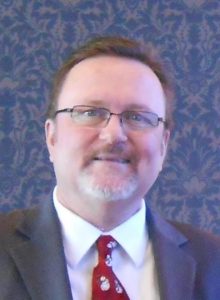 RESDC is proud to be participating in the Walk4ALZ to raise awareness and funds to advance the fight against Alzheimer’s disease. The Walk4ALZ is San Diego’s largest Alzheimer’s walk. It’s the only Alzheimer’s walk where 100% of every dollar raised stays in San Diego to support free services for families and local research for a cure. The end of Alzheimer’s starts with you and this is a great way to get in a good walk and show your support for the great work done by Alzheimer’s San Diego!
RESDC is proud to be participating in the Walk4ALZ to raise awareness and funds to advance the fight against Alzheimer’s disease. The Walk4ALZ is San Diego’s largest Alzheimer’s walk. It’s the only Alzheimer’s walk where 100% of every dollar raised stays in San Diego to support free services for families and local research for a cure. The end of Alzheimer’s starts with you and this is a great way to get in a good walk and show your support for the great work done by Alzheimer’s San Diego!
To register, go to www.resdc.net/community-events and click on “Team RESDC on the Walk4ALZ website.” If you’re unable to participate, please consider making a $35 donation to our fundraising campaign. Thank you!
 When: Saturday, October, 20, 2018
When: Saturday, October, 20, 2018
Registration and Check-in at 6:30 am. Walk at 8:00am.
Where: Balboa Park, start near the corner of Park and Presidents Way.
2131 Pan American Plaza, San Diego, CA 92101 ◾
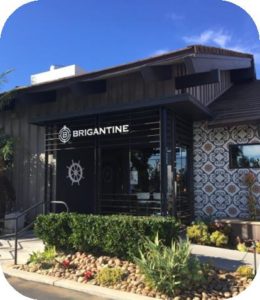 North County RESDC Roundup #3
North County RESDC Roundup #3
September 26, 2018, 3:30pm
Brigantine Restaurant, Escondido
A good time was had by all at our first two Roundups and it’s time for #3! We are heading to North County and hope you’ll join us for our get together.
The Roundup provides an opportunity to catch up over libations and appetizers with RESDC leadership and fellow members. No reservation required (no host bar). Come meet with old friends and make some new ones!
When
Wednesday, September 26, 2018
3:30 – 5:00pm
Where
Brigantine Restaurant
421 W Felicita Ave, Escondido, CA 92025
(The Brigantine is located in the Vons parking lot on the corner of Felicita and Centre City Parkway.) ◾
Pension Facts
Retirement Benefits “Over-Promised” Critics Claim
By Chris Heiserman, Director
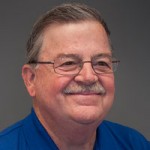 According to a new chorus from public pension critics, the primary reason so many American retirement systems are significantly underfunded is not because state and local governments have failed to make the recommended annual contributions to these investment funds. The real problem, they contend, is that retirement benefits for public employees have been “overpromised.”
According to a new chorus from public pension critics, the primary reason so many American retirement systems are significantly underfunded is not because state and local governments have failed to make the recommended annual contributions to these investment funds. The real problem, they contend, is that retirement benefits for public employees have been “overpromised.”
This appears to be another stanza of the old song from public pension opponents decrying traditional guaranteed retirement benefits as too lucrative. They suggest that growing pension obligations are outpacing the ability of state and local taxpayers to pay for them; and they attempt to bolster this theory with questionable logic and ridiculous comparisons between increases in retirement benefits and economic measures such as personal income, median household income and gross domestic product (GDP).
This is the newest misleading attack aimed at state and local workers who help fund the benefits they earn with dollars deducted from every paycheck. These employees hired on with the expectation of reasonable retirement security at the end of their careers, funded by their contributions, their employers’ contributions and long-term investment earnings.
In a recent study, Wirepoints, an Illinois-based policy group, compared the growth of state pension liabilities to state GDP and retirement fund assets. According to the study, which was highlighted in an editorial in the Wall Street Journal, accrued retirement obligations grew more than 50% faster than the economies in 28 states between 2003 and 2016.
The Wirepoints report (a 50-state survey) says it relied on 2003-2016 data from the Pew Charitable Trust and other sources. However, there are two obvious problems with this study. First, using Illinois, one of the most troubled pension systems in the nation as the poster child for their theory skews the analysis tremendously; and, second, any comparison of the growth in retirement liabilities to increases in overall economic growth in local jurisdictions or entire states is overly general and meaningless. Wirepoints oversimplifies the obvious in stating that the five states that kept pension benefit growth from “overwhelming” their economies were ones that had lower benefits to start with and enacted “reforms” such as freezing pensions for some workers, shifting new hires to 401(k) savings plans, cutting cost-of-living adjustments and increasing retirement age eligibility. So, these states reduced their future pension benefit obligations, and thus improved their overall economic positions, on the backs of their workers.
Another feeble attempt to lay the primary blame for strained state budgets at the feet of future public pension liabilities came recently from 24/7 Wall Street, a Delaware-based corporation which delivers (conservative) financial news and opinion over the internet. They apparently believe that publishing innocuous statistics that show which state retirement systems are the “best” funded will somehow reflect poorly on the role of pension benefit obligations in the government budgeting arena. They reviewed per capita state government retirement expenditure figures from the U.S. Census Bureau’s 2015 State and Local Government Expenditures data. They explain that states with high pension expenditures tend to have higher tax collections per capita, and that the size of the government work force bears no relationship to annual state pension payments. They also provide figures for 2015 tax collections per capita and a percentage for the current funded status of each state’s pension system. They then rank all 50 states from the lowest per-capita state retirement fund expenditures to the highest. California is number 34 at $88.4 per capita but the whole exercise is useless considering the vast diversity among states.
SDCERA Benefits Chided
A little bit different take on the same “overpromising benefits” theme comes from Transparent California. Transparent California is an organization that sponsors a popular website that publishes annual earnings data for all California active and retired public employees. It also prepares opinion articles and reports reflecting negatively on public retirement plans. In a recent blog post the organization reported a dramatic 1,237% increase in promised pension benefits from 1986-2016 for the San Diego County Employees’ Retirement Association (SDCERA), a growth rate it claimed “dwarfs” the county’s economic growth and “taxpayers’ ability to pay.” The organization then provides comparison data for a variety of San Diego County economic measures over the same 30-year period that have nothing to do with pension benefit levels: personal income, median household income, inflation, and population growth.
Transparent California correctly identifies a large benefit enhancement approved by the Board of Supervisors in 2002 as a primary factor in the retirement plan’s sizeable pension obligation increase viewed over three decades. It provides no detail at all to explain how comparisons with random economic data or population increases relate to SDCERA’s long term pension benefits tab. ◾
 Saving and Preparing for Long-Term Care
Saving and Preparing for Long-Term Care
Free Seminar with SDCCU Investment Services
There is still time to join us for this FREE educational seminar. Topics include:
- What is Long-Term Care?
- Realities of Long-Term Care
- Cost of Long-Term Care
Presenter: Heather Gappy, CLTC, Regional Sales Director, OneAmerica®. As Regional Sales Director for OneAmerica, Heather works with advisors and agents associated with large national broker dealers and wirehouses to discuss long-term care solutions. She provides training through group meetings and one-on-one Financial Advisor discussions. Heather worked as a commercial insurance broker and a Financial Advisor for several years before joining the Care Solutions team in 2007. She holds a Bachelor of Science in Business Administration—Emphasis in Finance from San Diego State University.
When
Wednesday, September 19 from 10:00 – 11:00am
Where
San Diego Workforce Partnership office
3910 University Avenue, San Diego, CA 92105
Julie Benedict Room on the 3rd Floor
RSVP
This is a FREE event. RSVP is requested: online by clicking here and following the steps, or by calling (619) 688-9229.
 Annual RESDC Membership Survey
Annual RESDC Membership Survey
It’s time for the annual Retired Employees of San Diego County, Inc. (RESDC) Membership Survey. Your participation in this study is completely voluntary. It is very important for us to learn your opinions so that we can better serve you!
The survey is available online now through Friday, September 14, 2018: click here to take the online survey. If you’re on our email list, you’ve already been sent the link to the survey. If you want to be added to the email list to get occasional updates and news, please contact resdc@resdc.net.
If you are unable to take the survey online for any reason, you can still participate by printing and mailing back the 2018 Membership Survey abridged version (PDF) by September 14, 2018 (the print version is also available in the mailed September NETWORK). Please only respond to the survey using one method: either online or by mail.
As a token of our appreciation, at the end of the survey you have the option to enter an Opportunity Drawing for a See’s Candy Certificate. Two survey respondents will be randomly selected to each receive a See’s Candy Certificate, good for a one pound ready-packed or specially packed box, redeemable at any of the See’s retail stores. You must be a current member of RESDC to participate in the opportunity drawing.
Survey responses are confidential. Data from this research will be reported only in the aggregate.
If you have questions, you may contact RESDC at (619) 688-9229 or by email at resdc@resdc.net. Thank you very much for your time and support! ◾
Recent Events
- State Supreme Court Rules Against City Of San Diego Pension Reform: On August 3, 2018, the state Supreme Court ruled that a San Diego citizens’ initiative that cut back city employee pensions was illegally placed on the ballot, and ordered an appeal court to consider a remedy. Proposition B, initially approved by voters in 2012, eliminated guaranteed pensions for new city employees, except police officers, and replaced those benefits with 401(k)-style retirement plans. In overturning the Public Employees Relations Board ruling in 2017, the appeal court took an “unduly constricted view of the duty to meet and confer,” according to the Supreme Court ruling. The Supreme Court ruled that the appeal court address an “appropriate judicial remedy” for the illegal placement of the initiative on the ballot. The Public Employees Relations Board had previously ruled the city must pay employees “for all lost compensation” related to lost pension benefits which would cost millions of dollars.
- New Research Brief—What Explains Differences in Public Pension Returns Since 2001? According to this brief, recently released by the Center for Retirement Research at Boston College, the funded status of public pensions depends on two major factors—the payment of plan sponsors’ annual required contribution and the investment return earned on pension fund assets. This brief documents the investment performance of public plans from 2001-2016 and investigates the two main factors underlying disparities among plans: 1) differences in asset allocation; and 2) differences in the realized returns within each asset class. To access this brief, visit: http://crr.bc.edu/category/briefs/ ◾
San Diego County Credit Union

Are you taking advantage of SDCCU’s FREE Checking with eStatements? Access over 30,000 surcharge-FREE CO-OP ATMs nationwide. Open an account in minutes and free yourself of monthly activity fees. When you direct deposit your pension into your SDCCU® checking account, you many enjoy it earlier than your regularly scheduled payday. Sign up for direct deposit at sdccu.com/directdeposit today to start enjoying your paycheck early! Restricitons apply. Actual deposit date not guaranteed. Federally insured by NCUA. ◾
Annual RESDC Health Fair Picnic
 When
When
Tuesday, October 23, 2018, 10:00 am—1:00 pm
Lunch Served 11:30 am—12:30 pm
Where
Admiral Baker Field
2400 Admiral Baker Rd., San Diego, CA 92124 (Map)
(directions listed below)
What
The annual RESDC Health Fair Picnic is an outdoor event with over 20 resource booths related to health and wellness. Enjoy a buffet style barbecue lunch, an opportunity drawing, and mingling with fellow retirees.
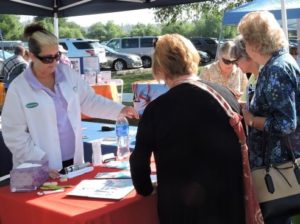 Menu
Menu
Barbecued beef, green beans, baked beans, fruit, coleslaw, rolls, beverages, and dessert.
Sponsored By
Ameritas Dental, Cigna Dental, Health Net, Kaiser Permanente, Pacific Group Agencies, Inc., San Diego County Credit Union, United HealthCare, and My Senior Health Plan.
Registration
EVERYONE, INCLUDING MEMBERS, MUST REGISTER IN ADVANCE.
This ensures we order enough food for everyone and are in compliance with the policy of Admiral Baker Field to not complete financial transactions onsite. Thank you for your cooperation!
RESDC Members: $0
Non-Members: $5
Spouses, guests, retirees who have not joined RESDC, etc. are required to pay $5 each.
Registration forms and payment must be received in the RESDC office by Thursday, October 18. There are no refunds. Name badges and opportunity drawing tickets should be picked up at the Check-In table. They will not be mailed. No pets are allowed at Admiral Baker Field except Service Animals.
Choose Registration Method:
Register by Phone: Call the RESDC Office at (619) 688-9229 during our hours of 9 am – 2 pm Mon-Fri. If you are bringing non-member guests, please have a credit card ready.
Register by Mail: Print and fill out the registration form. Make a check payable to RESDC for $5 per non-member in your group. Mail form and check (if applicable) to RESDC, 8825 Aero Dr., Suite 205, San Diego, CA 92123.
Register Online: Click the green “Register” button. To access the free RESDC member price, use the email associated with your member account. Click “Add guest” to add non-member attendees for $5 each. To pay for non-member attendees, click “Pay Online” and pay with credit card; otherwise, click “Confirm.” To add another RESDC member, please call RESDC at (619) 688-9229.
Register online for Health Fair Picnic →
Directions to Admiral Baker Field
If using Route 15:
Turn East onto Friars Road and left on Santo Road, Right on Admiral Baker Road, and turn right at the next stop sign.
If using Route 8:
Take 8 to Route 15 North, turn East onto Friars Road, left on Santo Road, and Right on Admiral Baker Road, turn right at the next stop sign.
Upon entering the park, there will be signs to direct you. ◾
Bits and Pieces
John Jurgens and his wife, Lisa, took a 1,700 mile motorcycle trip from their home in North Idaho to the Olympic Peninsula in the Northwest. They named this magnificent trip their “waterfalls and lighthouse tour.” John retired from Probation in 1998.
Ed Kues and his wife, Yukiko, celebrated their 63rd anniversary in June! Ed retired in 1992 after 19 years with the county as a Probation Officer. He turned 89 in March.
Rebecca Alvarez retired in 2013 from the Public Defenders office. This year she traveled to Israel with a tour group from her church. This was a very moving one week trip. They stayed in Old Jerusalem and walked the same places where Jesus walked. She visited the Dead Sea, the Jordan River, Jericho, the Wailing Wall, and the Mediterranean Sea. ◾
Welcome New Members
Maria Adame-Chavez* – Human Resources
Diane Andriotou – Auditor & Controller
Yolanda Brennen
Neil Connelly
Tracy J. DeFore* – Communications
Bonnie Dumanis – District Attorney
Thomas Escajeda – SDCERA
Clifford D. Gilbert
Yolanda J. Herlich
Judith A. Morrison
Kathleen S. Murphy* – Human Resources
Robyn Phelps – Health & Human Resources
Juanita Rettinghaus* – Behavioral Health Services
*Associate Member
The surviving Spouse of a member is eligible for RESDC membership. For enrollment assistance, please call: (866) 688-9229. ◾
NETWORK is the official monthly newsletter of the Retired Employees of San Diego County, Inc. (RESDC), a private non-profit organization.
The information printed in the NETWORK is believed to be from reliable sources. However, no responsibility is assumed by the NETWORK for inaccuracies contained herein.
Business and Inquiries: Business matters and address changes may be recorded on our voicemail at any time, call (866) 688-9229. Please spell your name so the correct member record can be located.
Retired Employees of San Diego County, Inc.
8825 Aero Drive, Suite 205 | San Diego, CA 92123
Office Hours: 9 a.m. to 2 p.m. Monday through Friday
TELEPHONE: (866) 688-9229 Toll Free
FAX: (619) 688-0766
E-MAIL: resdc@resdc.net


